I was interested in the Naturehike Cloud Up 1-person tent and noticed a complaint by an angry customer. But I realized that it did not make any sense, and I ordered the tent. Read more here.
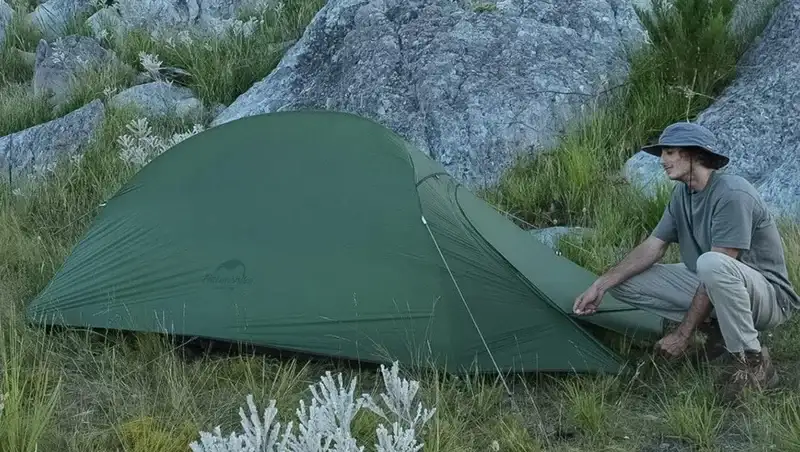
Why this text
I recently came across an angry Amazon review about a tent, and it got me thinking about a topic I want to address: condensation in tents.
The reviewer complained about a Naturehike Cloud Up 1-person tent, the picture above, saying it got wet inside due to condensation during a two-week motorcycle trip.
He woke up after the first night, found the stuff wet, saw the outer shell soaked on the inside, and demanded their money back. He even said, “Don’t waste your money.” Someone marked the review as helpful, which I think is misleading, but see it yourself:

Here’s why this complaint is unfair, and what you need to know about condensation in tents.
First, let’s get this straight: condensation happens in all synthetic tents, no matter the price or brand. It depends on weather conditions, sometimes you will have more, sometimes less.
It doesn’t matter if your tent has perfect ventilation, floor vents, roof vents, or whatever. You will always get condensation to some degree.
I have seen it myself. I own a Snow Peak Alpha Breeze, a top-notch tent with some of the best ventilation you can find. I often use it at my short one-night stays in official campsites as a living room for cooking or working on my computer, not for sleeping. I sleep in my car on those short trips.

One morning, I entered the tent after leaving it up overnight at a campsite. I wasn’t even sleeping in it, but the underside of the fly was completely wet with condensation, see the picture above.
This proves my point: condensation happens even if you are not in the tent. But see the tent below, this is it in the Dolomiti camp at Cortina d’Ampezzo:
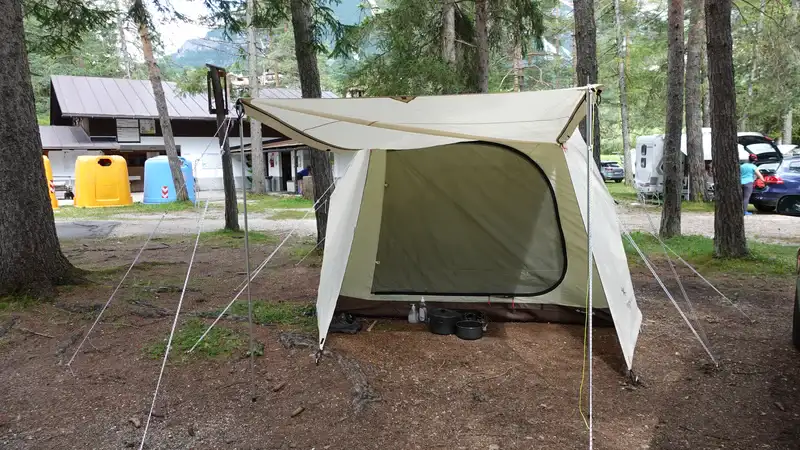
Why condensation happen even in an empty tent?
In a two-layer tent, like most synthetic tents with an inner canopy and a fly, moisture from the ground rises, gets trapped under the fly, and condenses on the underside.
I guess I would be able to say a bit more here, namely I am a theoretical physicist and I know a few details about such things. But no need, you can set up an empty tent in your garden overnight and check in the morning; you will likely see the same thing.
Single-layer tents might not have this issue as much because there is no separate fly trapping moisture from the ground underneath, but that doesn’t make them better. We typically use tents for sleeping, not as empty shelters, and single-layer tents have their own separate problems.
Now, back to the Naturehike Cloud Up 1-person tent the reviewer complained about. When I read the complaint, this was because I was interested in the tent. So, I did not have the tent yet, but you will read below what happened.
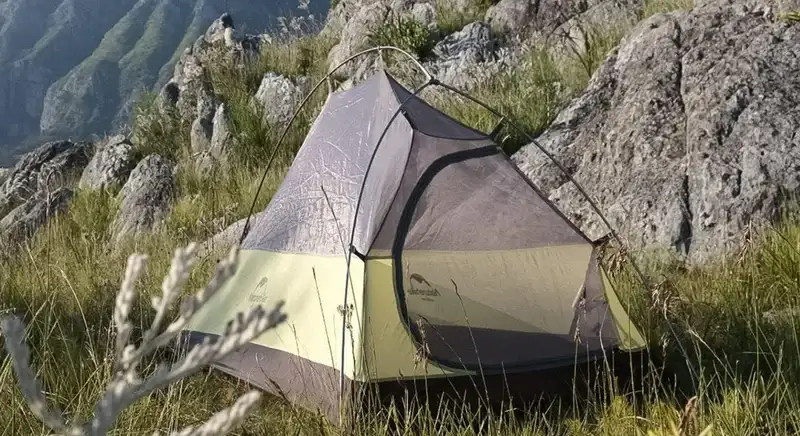
I currently use a Ferrino Lightent 1, a lightweight tent for high mountain trips far from my car. It is too small to sit in or cook in, and when it rains, it is a pain to pack up. I have written about this on my site before.
The Naturehike tent is affordable, and I have seen good reviews about it, including a video from someone who used it for two years and had only positive things to say. So I looked into its design to see if the reviewer’s complaint holds up.
The Cloud Up is a two-layer tent: an inner mesh canopy (the picture above) and a full-coverage fly. The fly has several stake-out points, so you can maximize airflow from the ground. It also has a roof vent, properly positioned to avoid letting rain in.
From what I can see, there is nothing in the design that makes it particularly bad for condensation. Compare that to an MSR Habiscape 6-Person Family Camping Tent, a well-known brand with a solid reputation. It is also a two-layer tent, but it has no roof vent, which is worse for ventilation, especially for a 6-person tent. Yet MSR is a respected name.
This shows even big brands don’t always get it perfect, but it doesn’t mean the Naturehike tent is poorly designed.
The reviewer’s complaint about condensation isn’t justified. He didn’t understand how tents work. Condensation is normal, it is not a design flaw.
If you are writing comments or complaints about gear, be fair. Know how the product works before you blame it. Condensation isn’t the tent’s fault, it is just physics.
If you have had similar experiences or have thoughts on the Naturehike Cloud Up, let me know in the comments. In fact, I am thinking of buying it and this is how I found the mentioned complaint.
Instead of conclusion
As I mentioned, I was in search of a backpack-portable and affordable solo tent, and I wanted a model that would allow me to sit inside, and also offer a space to cook when it rains outside. You cannot do anything of it in a bivy tent.
While checking the features of the mentioned Naturehike Cloud Up tent, I realized that they have yet another version of it on the market under the name Naturehike Cloud Up Pro Tent 1 Person, see the picture.
It has the same shape and dimensions, and it is available in several colors and they have polyester and nylon versions, so I decided to order it. Oh yes, the price was actually lower than the standard version.
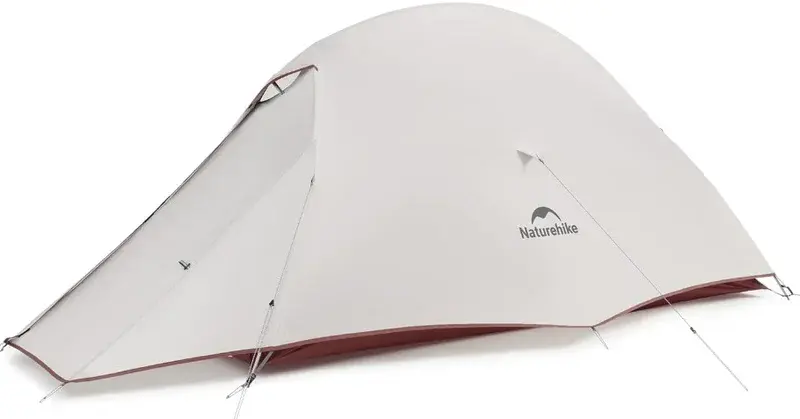
I decided to buy this Pro version because of its slightly higher door. In addition, I chose the color in the picture because I shall use it only on high elevations 2000-3000 meters, and it will blend nicely in a rocky environment, and it was cheaper that the other three colors. I ordered it from Amazon-DE, but it is available also at Amazon-US.
Below you can see my order, I wanted to show you to see the incredible price, simply amazing for a sil-nylon tent with a 3000 mm waterproof rating and free delivery.
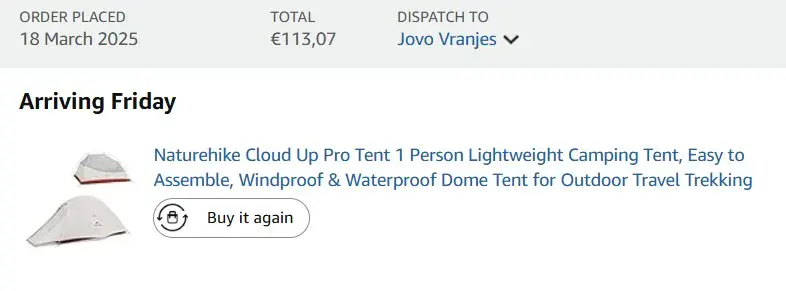
As you realize, this story contains an interesting twist, from somebody’s negative comment and complaint about a tent to my order of this potentially excellent tent. Later, I shall have a review here in the site, and also a report about its testing in the mountains. So, stay tuned.
Thank you for reading. Let me know if you have questions or comments, there is a comment box below. Subscribe to my weakly newsletter and stay informed, the subscription form is given below.
Leave a Reply